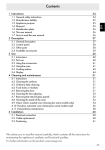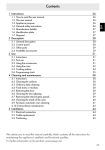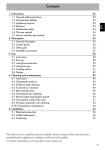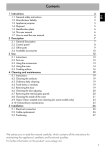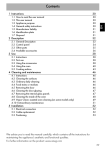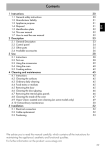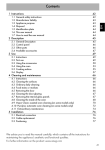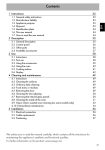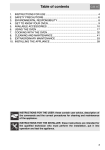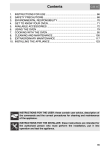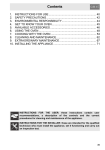Download Smeg SFP750BS
Transcript
Contents 1.1 1.2 1.3 1.4 1.5 1.6 1.7 How to read the user manual This user manual Appliance purpose General safety instructions Manufacturer liability Identification plate Disposal 2 Description 2.1 2.2 2.3 2.4 General Description Control panel Other parts Available accessories 3 Use 3.1 3.2 3.3 3.4 3.5 3.6 3.7 32 32 32 32 32 33 33 33 EN 1 Instructions 34 34 35 36 36 38 Instructions First use Using the accessories Using the oven Cooking advice Analogue (multifunction) programmer Analogue (pyrolytic) programmer 4 Cleaning and maintenance 4.1 Instructions 4.2 Cleaning the surfaces 4.3 Ordinary daily cleaning 4.4 Food stains or residues 4.5 Removing the door 4.6 Cleaning the door glazing 4.7 Removing the internal glass panels 4.8 Cleaning the inside of the oven 4.9 Vapor Clean: assisted oven cleaning (on some models only) 4.10 Pyrolysis: automatic oven cleaning (on some models only) 4.11 Extraordinary maintenance 5 Installation 5.1 Electrical connection 5.2 Cable replacement 5.3 Positioning 38 38 39 40 42 44 45 48 48 48 48 48 48 49 49 50 51 53 54 56 56 56 57 We advise you to read this manual carefully, which contains all the instructions for maintaining the appliance's aesthetic and functional qualities. For further information on the product: www.smeg.com 31 Instructions 1 Instructions 1.1 How to read the user manual This user manual uses the following reading conventions: Instructions General information on this user manual, on safety and final disposal. Description Description of the appliance and its accessories. Use Information on the use of the appliance and its accessories, cooking advice. Cleaning and maintenance Information for proper cleaning and maintenance of the appliance. Installation Information for the qualified technician: installation, operation and inspection. Safety instructions Information Advice 1. Use instruction sequence. • Single use instruction. 32 1.2 This user manual This user manual is an integral part of the appliance and must therefore be kept in its entirety and in an accessible place for the whole working life of the appliance. 1.3 Appliance purpose This appliance is intended for cooking food in the home environment. Every other use is considered improper. This appliance must not be used by people (including children) of reduced physical and mental capacity, or lacking in experience in the use of electrical appliances, unless they are supervised or instructed by adults who are responsible for their safety. 1.4 General safety instructions For your safety and to avoid damage to the appliance, always respect the general safety instructions indicated below. In general • Have qualified personnel carry out installation and assistance interventions according to the standards in force. • Read this user manual carefully before using the appliance. • Do not modify this appliance. • Do not try to repair the appliance yourself or without the intervention of a qualified technician. • If the power supply cable is damaged, contact technical support immediately and they will replace it. For this appliance • Do not obstruct ventilation openings and heat dispersal slots. • Do not insert pointed metal objects (cutlery or utensils) into the slots in the appliance. • Do not rest any weight or sit on the open door of the appliance. • Take care that no objects are stuck in the doors. • Do not use the appliance to heat rooms for any reason. 1.5 Manufacturer liability The manufacturer declines all liability for damage to persons or property caused by: • use of the appliance other than the one envisaged, • non-observance of the user manual provisions, • tampering with any part of the appliance, • use of non-original spare parts. 1.6 Identification plate The identification plate bears the technical data, serial number and brand name of the appliance. Do not remove the identification plate for any reason. 1.7 Disposal This appliance must be disposed of separately from other waste (Directives 2002/95/EC, 2002/ 96/EC, 2003/108/EC). The appliance does not contain substances in quantities sufficient to be considered hazardous to health and the environment, in accordance with current European directives. To dispose of the appliance: • Remove the doors and leave the accessories (racks and trays) in their usual working positions, so that children cannot get stuck in the oven compartment. • Cut the power supply cable and remove it along with the plug. Power voltage Danger of electrocution • Disconnect the main power supply. • Disconnect the power cable from the electrical system. • Consign the appliance to the appropriate selective collection centres for electrical and electronic equipment waste, or deliver it back to the retailer when purchasing an equivalent product, on a one for one basis. Our appliances are packed in nonpolluting and recyclable materials. • Consign the packing materials to the appropriate selective collection centres. Plastic packaging Danger of suffocation • Do not leave the packaging or any part of it unattended. • Do not let children play with the packaging plastic bags. 33 EN Instructions Description 2 Description 2.1 General Description Multifunction models Pyrolytic models 1 Control panel 2 Oven light 3 Seal 4 Door 34 5 Fan 6 Rack/tray support frames Frame shelf Description EN 2.2 Control panel Multifunction models Pyrolytic models Temperature knob (1) This knob allows you to select the cooking temperature and the Vapor Clean temperature (on some models only). Turn the knob clockwise to the required value, between the minimum and maximum settings. Thermostat indicator light (2) In pyrolytic models, the light switches on when the automatic cleaning cycle (pyrolysis) starts and remains lit until the cycle is complete. Programming clock (3) Useful for displaying the current time, set programmed cooking operations and program the timer. When the indicator light is flashing, it indicates that the oven is heating up to reach the set temperature. Once the temperature has been reached, the light remains lit until the oven is switched off. 35 Description Door lock indicator light (4) Interior lighting In pyrolytic models it comes on when the automatic cleaning cycle (Pyrolysis) is activated. The oven light comes on when the door is opened or any function is selected, except for . Function knob (5) 2.4 Available accessories The oven's various functions are suitable for different cooking modes. After selecting the required function, set the cooking temperature using the temperature knob. 2.3 Other parts Some models are not provided with all accessories. Rack Shelves The appliance features shelves for positioning trays and racks at different heights. The insertion heights are indicated from the bottom upwards (see 2.1 General Description). Cooling fan Useful for supporting containers with food during cooking. Tray rack The fan cools the oven and comes into operation during cooking. The fan causes a steady outflow of air from above the door which may continue for a brief period of time even after the appliance has been turned off. 36 To be placed over the top of the oven tray; for cooking foods which may drip. Description Rotisserie support EN Oven tray To be used to support the rotisserie rod. Useful for collecting grease and fat dripping from foods placed on the rack above. Rotisserie rod Deep tray Useful for cooking chicken and all foods which require uniform cooking over their entire surface. Useful for collecting fat from foods placed on the rack above and for cooking pies, pizzas and baked desserts. The oven accessories intended to come into contact with food are made of materials that comply with the provisions of current legislation. Original supplied or optional accessories can be requested from authorised assistance centres. Use only original accessories supplied by the manufacturer. 37 Use 3 Use 3.1 Instructions High temperature inside the oven during use Danger of burns • Keep the oven door closed during cooking. • Protect your hands wearing heat resistant gloves when moving food inside the oven. • Do not touch the heating elements inside the oven. • Do not pour water directly onto very hot trays. • Do not allow children to get near the oven when it is in operation. High temperature inside the oven during use Danger of fire or explosion • Do not spray any spray products near the oven. • Do not use or leave flammable materials near the oven. • Do not use plastic kitchenware or containers when cooking food. • Do not put sealed tins or containers in the oven. • Do not leave the oven unattended during cooking operations where fats or oils could be released. • Remove all trays and racks which are not required during cooking. 38 Improper use Risk of damage to enamelled surfaces • Do not cover the bottom of the cooking compartment with aluminium or tin foil sheets. • If you wish to use greaseproof paper, place it so that it will not interfere with the hot air circulation inside the oven. • Do not place pans or trays directly on the bottom of the cooking compartment. • Do not pour water directly onto very hot trays. 3.2 First use 1. Remove any protective film from the outside or inside of the appliance, including accessories. 2. Remove any labels (apart from the technical data plate) from the accessories and from the cooking compartment. 3. Remove and wash all the appliance accessories (see 4 Cleaning and maintenance). 4. Heat the empty oven at the maximum temperature to burn off any residues left by the manufacturing process. 3.3 Using the accessories Tray rack Racks and trays The tray rack has to be inserted into the tray. In this way fat can be collected separately from the food which is being cooked. Racks and trays have to be inserted into the side guides until they come to a complete stop. • The mechanical safety locks that prevent the rack from being taken out accidentally have to face downwards and towards the oven back. Rotisserie rod When cooking with the rotisserie, position the rotisserie support frame on the third shelf. Once the rod frame is inserted, the shaped part must sit facing outwards. Prepare the rotisserie rod with the food using the clip forks provided. Gently insert racks and trays into the oven until they come to a stop. Clean the trays before using them for the first time to remove any residues left by the manufacturing process. 39 EN Use Use Screw on the handle provided so that you can handle the rod with the food on it readily. 3.4 Using the oven Switching the oven on To switch the oven on: 1. Select the cooking function using the function knob. 2. Select the temperature using the temperature knob. Functions list Once you have prepared the rotisserie rod, place it on the the rotisserie support. Insert the rod into the hole A so that it connects with the rotisserie motor. Make sure that the pin is correctly positioned on the shaped part of the rotisserie support B. We recommend that you place the tray on the first shelf to collect fats more easily. 40 Static As the heat comes from above and below at the same time, this system is particularly suitable for certain types of food. Traditional cooking, also known as static cooking, is suitable for cooking just one dish at a time. Perfect for all types of roasts, bread and cakes and in any case particularly suitable for fatty meats such as goose and duck. Grill The heat coming from the grill element gives perfect grilling results above all for thin and medium thickness meat and in combination with the rotisserie (where fitted) gives the food an even browning at the end of cooking. Perfect for sausages, ribs and bacon. This function enables large quantities of food, particularly meat, to be grilled evenly. Fan-assisted bottom The combination of the fan with just the lower heating element allows cooking to be completed more rapidly. This system is recommended for sterilising or for finishing off the cooking of foods which are already well-cooked on the surface, but not inside, which therefore need a little more heat. Perfect for any type of food. In pyrolytic models, the special defrosting and proving functions are brought together under the same function. Fan-assisted grill The air produced by the fan softens the strong heatwave generated by the grill, grilling perfectly even very thick foods. Perfect for large cuts of meat (e.g. shin of pork). Fan-assisted static The operation of the fan, combined with traditional cooking, ensures uniform cooking even with complex recipes. Perfect for biscuits and cakes, even when simultaneously cooked on several levels. (For multiple-level cooking, we recommend using the 2nd and 4th shelves.) Bottom The heat coming just from the bottom allows you to complete the cooking of foods that require a higher bottom temperature, without affecting their browning. Perfect for cakes, pies, tarts and pizzas. Turbo The combination of fan-assisted cooking and traditional cooking allows different foods to be cooked on several levels extremely quickly and efficiently, without odours and flavours mingling. Perfect for large volumes that call for intense cooking. Fan-assisted small grill Through the combined action of the fan and the heat of the central element only, this function is perfect for rapid cooking and cooking au gratin of small quantities of food (particularly meats), by bringing together the dietary advantages of the grill and the even cooking of the fan. Rotisserie grill The rotisserie works in combination with the grill element, allowing food to be perfectly browned. 41 EN Use Use Fan-assisted circular The combination of the fan and the circular element (incorporated in the rear of the oven) allows you to cook different foods on several levels, as long as they need the same temperatures and same type of cooking. Hot air circulation ensures instant and uniform distribution of heat. It will be possible, for instance, to cook fish, vegetables and biscuits simultaneously (on different levels) without mixing odours and flavours. Defrosting Rapid defrosting is helped by switching on the fan provided and the top heating element that ensure uniform distribution of low temperature air inside the oven. Eco Using the grill and the lower heating element in combination is particularly suitable for cooking on a single shelf, as it provides low energy consumption. 42 Vapor Clean This function makes cleaning easier using the steam produced by a little quantity of water poured onto the appropriate drawing placed on the bottom. Pyrolysis Setting this function, the oven reaches temperatures up to 500°C, destroying all the grease which forms on the internal walls. 3.5 Cooking advice General advice • Use a fan-assisted function to achieve uniform cooking at several levels. • It is not possible to shorten cooking times by increasing the temperature (the food could be overcooked on the outside and undercooked on the inside). Advice for cooking meat • Cooking times vary according to the thickness and quality of the food and to consumer taste. • Use a meat thermometer when roasting meat, or simply press on the roast with a spoon. If it is hard, it is ready; if not, it needs another few minutes cooking. Use Advice for defrosting and proving • Meat can be grilled even when it is put into the cold oven or into the preheated oven if you wish to change the effect of the cooking. • With the fan-assisted grill function, preheating the oven before grilling is recommended. • We recommend placing the food at the centre of the rack. • With the Grill function, it is recommended to turn the temperature dial to the highest value – symbol – to optimise cooking. • Place frozen foods without their packaging in a lidless container on the first shelf of the oven. • Avoid overlapping the food. • To defrost meat, use the rack placed on the second level and a tray on the first level. In this way, the liquid from the defrosting food drains away from the food. • The most delicate parts can be covered with aluminium foil. • For successful proving, a container of water should be placed in the bottom of the oven. Advice for cooking desserts and biscuits To save energy • Dark coloured metal moulds and tins should preferably be used as they help to absorb the heat. • The temperature and the cooking time depend on the quality and consistency of the dough. • To check whether the dessert is cooked right through: at the end of the cooking time, put a toothpick into the highest point of the dessert. If the dough does not stick to the toothpick, the dessert is cooked. • If the dessert collapses when it comes out of the oven, on the next occasion reduce the set temperature by about 10°C, selecting a longer cooking time if necessary. • Stop cooking a few minutes before the time normally used. Cooking will continue for the remaining minutes with the heat which has accumulated inside the oven. • Reduce any opening of the door to a minimum to avoid heat dispersal. • Keep the inside of the appliance clean at all times. 43 EN Advice for cooking with the Grill and the Fan-assisted grill Use 3.6 Analogue (multifunction) programmer A Setting knob B Cooking start pointer Setting the time To set the time, pull out setting knob A and turn it clockwise. Manual cooking Turn setting knob A clockwise until the cooking start pointer B lines up with the symbol. 44 Timed cooking Timed cooking is the function which allows a cooking operation to be started and then ended after a specific length of time set by the user. 1. After selecting a cooking function and temperature, turn the setting knob A. 2. Turn the cooking start pointer B to the desired time indicated in the centre of the clock (0... 180 minutes). 3. When the set time has elapsed, all heating elements will turn off and a buzzer will sound. 4. To turn off the buzzer, turn the setting knob A clockwise to the symbol. 3.7 Analogue (pyrolytic) programmer A Setting knob B Cooking start pointer C Cooking symbol window Setting the time To set the time, push in setting knob A and turn it anticlockwise. Manual cooking 1. Rotate setting knob A until the symbol appears in cooking symbol window C. 2. Pull out setting knob A, turn it clockwise to position the cooking start pointer B to the current time. 3. Turn setting knob A clockwise until the symbol appears in cooking symbol window C. 4. Use the appropriate knobs to select a function and cooking temperature to start manual cooking. 5. When cooking has finished, turn the function and temperature knobs to the 0 position. Timed cooking Timed cooking is the function which allows a cooking operation to be started and then ended after a specific length of time set by the user. 1. Rotate setting knob A until the symbol appears in cooking symbol window C. 2. Pull out setting knob A, turn it clockwise to position the cooking start pointer B to the current time. 45 EN Use Use 3. Turn setting knob A clockwise until the desired cooking time (0... 180 minutes) is selected in the cooking symbol window C. 4. Select a function and cooking temperature with the appropriate knobs. Timed cooking will start at the set time. 5. When the set time has elapsed, all heating elements will turn off and a buzzer will sound. 6. To turn off the buzzer, turn the setting knob A clockwise to the symbol. Programmed cooking Programmed cooking is the function which allows a cooking operation to be started at a set time and then ended after a specific length of time set by the user. 1. Rotate setting knob A until the symbol appears in cooking symbol window C. 2. Pull out setting knob A, turn it clockwise to position the cooking start pointer B to the time set for the cooking start. 46 3. Turn setting knob A clockwise until the desired cooking time (0... 180 minutes) is selected in the cooking symbol window C. 4. Select a function and cooking temperature with the appropriate knobs. Programmed cooking will start at the set time. 5. When the set time has elapsed, all heating elements will turn off and a buzzer will sound. 6. To turn off the buzzer, turn the setting knob A clockwise to the symbol. The cooking start time cannot be more than 12 hours ahead of the current time. Use Cooking information table Lasagne Oven-baked pasta Roast veal Pork loin Pork shoulder Roast rabbit Turkey breast Roast pork neck Roast chicken Weight (Kg) Function 3 2.5 Static Static 1 1 1 1 1 1 1 Fan-assisted static Fan-assisted static Turbo Circular Fan-assisted static Turbo Turbo Runner position from the bottom 1 or 2 1 or 2 Temperature 220 - 230 220 - 230 40 - 50 40 2 2 2 2 2 2 2 180 - 190 180 - 190 180 - 190 180 - 190 180 - 190 180 - 190 190 - 200 70 - 80 70 - 80 90 - 100 70 - 80 110 - 120 190 - 210 60 - 70 (°C) Time (minutes) EN Food 1st surface 2nd surface Pork chops Pork fillet Beef fillet Liver slices Sausages Meatballs Salmon trout Pizza Bread Focaccia Ring cake Fruit tart Short pastry Jam tarts Paradise cake Cream puffs Light sponge cake Rice pudding Brioche Apple pie 0.7 Fan-assisted grill Grill Grill Fan-assisted grill Fan-assisted grill Grill 4 3 3 4 3 3 250 - 280 250 - 280 250 - 280 250 - 280 250 - 280 250 - 280 Fan-assisted bottom 2 160 - 170 35 - 40 Circular Circular 1 2 2 280 190 - 200 180 - 190 8 30 - 35 15 - 20 Circular Circular/Static Circular Circular Circular/Static Circular Circular Circular/Static Circular Static 2 2 2 2 2 2 2 2 2 3 160 - 170 160 - 170 160 - 170 170 170 150 - 160 150 - 160 160 - 170 160 180 50 - 55 30 - 40 20 - 25 20 - 25 50 - 60 40 - 50 45 - 50 50 - 60 25 - 30 60 Circular 7-9 9 - 11 9 - 11 2-3 7-9 7-9 5-7 5-9 9 - 11 2-3 5-6 5-6 The times indicated in the table do not include preheating time, and are only approximate. 47 Cleaning and maintenance 4 Cleaning and maintenance 4.1 Instructions Improper use Risk of damage to surfaces • Do not use steam jets for cleaning the appliance. • Do not use cleaning products containing chlorine, ammonia or bleach on steel parts or parts with metallic finishes on the surface (e.g. anodizing, nickel- or chromium-plating). • Do not use abrasive or corrosive detergents on glass parts (e.g. powder products, stain removers and metallic sponges). • Do not use rough or abrasive materials or sharp metal scrapers. 4.2 Cleaning the surfaces To keep the surfaces in good condition, they should be cleaned regularly after use. Let them cool first. 4.3 Ordinary daily cleaning Always use only specific products that do not contain abrasives or chlorine-based acids. Pour the product onto a damp cloth and wipe the surface, rinse thoroughly and dry with a soft cloth or a microfibre cloth. 4.4 Food stains or residues Do not use metallic sponges or sharp scrapers as they will damage the surfaces. Use ordinary non-abrasive products with the aid of wooden or plastic utensils if necessary. Rinse thoroughly and dry with a soft cloth or a microfibre cloth. 48 Do not allow residues of sugary foods (such as jam) to set inside the oven. If left to set for too long, they might damage the enamel lining of the oven. 4.5 Removing the door For easier cleaning, the door can be removed and placed on a canvas. To remove the door proceed as follows: 1. Open the door completely and insert two pins into the holes on the hinges indicated in the figure. 2. Grasp the door on both sides with both hands, lift it forming an angle of around 30° and remove it. Cleaning and maintenance 3. To reassemble the door, put the hinges in the relevant slots in the oven, making sure that grooved sections A are resting completely in the slots. Lower the door and once it is in place remove the pins from the holes in the hinges. For easier cleaning the door internal glass panels can be disassembled. 1. Remove the internal glass panel by pulling the rear part gently upwards, following the movement indicated by the arrows (1). 2. Then, pull the front part upwards (2). In this way, the 4 pins attached to the glass detach from their housings in the oven door. 3. An intermediate glass panel is fitted to some models. Remove the intermediate glass panel by lifting it upwards. 4.6 Cleaning the door glazing The glass in the door should always be kept thoroughly clean. Use absorbent kitchen roll. In case of stubborn dirt, wash with a damp sponge and an ordinary detergent. We recommend the use of cleaning products distributed by the manufacturer. 49 EN 4.7 Removing the internal glass panels Cleaning and maintenance 4. Clean the external glass panel and the panels previously removed. Use absorbent kitchen roll. In case of stubborn dirt, wash with a damp sponge and neutral detergent. 4.8 Cleaning the inside of the oven 5. Refit the panels in the reverse order in which they were removed. 6. Reposition the internal glass panel. Take care to centre and insert the 4 pins into their housings in the oven door by applying slight pressure. Clean the oven racks with warm water and non-abrasive detergent. Carefully rinse and dry the damp parts. For the best oven upkeep, clean it regularly after having allowed it to cool. Take out all removable parts. The oven should be operated at the maximum temperature for about 15-20 minutes after the use of specific products, to burn off the residues left inside the oven. For easier cleaning, remove the door. 50 Cleaning and maintenance Removing the guide frames enables the sides to be cleaned more easily. This operation must be performed whenever the automatic cleaning cycle is performed (selected models only). Removing the guide frames. Pull the guide frames towards the inside of the oven so as to remove it from groove A, then unhook it from the attachment points B on the back. When cleaning is complete, repeat the above procedures to put the guide frames back in. 4.9 Vapor Clean: assisted oven cleaning (on some models only) Vapor Clean is an assisted cleaning procedure which facilitates the removal of dirt. Thanks to this process, it is possible to clean the inside of the oven very easily. The dirt residues are softened by the heat and water vapour for easier removal afterwards. Improper use Risk of damage to surfaces • Remove food residue and drips from previous cooking from the inside of the oven. • Carry out assisted oven cleaning operations only when the oven is cold. Preliminary operations Before starting the Vapor Clean cycle: • Completely remove all accessories from inside the oven. The upper guard can be left inside the oven. • Pour approx. 40 cc of water onto the floor of the oven. Make sure it does not overflow out of the cavity. 51 EN Removing racks/trays support frames Cleaning and maintenance • Spray a water and washing up liquid solution inside the oven using a spray nozzle. Direct the spray against the side walls, upwards, downwards and towards the deflector. • Close the door. We recommend spraying approx. 20 times at the most. Vapor Clean setting 1. Turn the function knob and the temperature knob to the symbol. 2. Set a cooking time of 18 minutes using the cooking time procedure described in more detail in “Timed cooking”; 3. At the end of the Vapor Clean cleaning cycle, the timer will turn off the oven's heating elements and a buzzer will sound. 4. To turn off the buzzer, turn the setting knob A clockwise to the symbol. 52 End of the Vapor Clean cycle 5. Open the door and wipe away the less stubborn dirt with a microfibre cloth. 6. Use an anti-scratch sponge with brass filaments on tougher encrustations. 7. In case of grease residues use specific oven cleaning products. 8. Remove the water left inside the oven. 9. For improved hygiene and to avoid food being affected by any unpleasant odours, we recommend that the oven is dried using a fan-assisted function at 160°C for approximately 10 minutes. It is recommended to use rubber gloves during these operations. For easier manual cleaning of the parts difficult to reach, we recommend removing the door. Cleaning and maintenance Pyrolysis is an automatic hightemperature cleaning procedure which causes dirt to dissolve. Thanks to this process, it is possible to clean the inside of the oven very easily. Improper use Risk of damage to surfaces • Remove food residue and drips from previous cooking from the inside of the oven. • Switch off the burners or electric hot plates of the hob installed above the oven. Preliminary operations Before starting the pyrolysis cycle: • Clean the internal glass panel following the usual cleaning instructions. • For very stubborn encrustations spray an oven cleaning product onto the glass (read the warnings on the product); leave for 60 minutes, then rinse and dry the glass using kitchen roll or a microfibre cloth. • Completely remove all accessories from inside the oven. • Remove the racks/trays support frames. • Close the door. Pyrolysis setting 1. Turn the function knob to symbol . 2. Turn setting knob A anticlockwise to set the duration of pyrolysis visible in the cooking symbol window C. Recommended pyrolysis duration: • Light dirt: 120 minutes. • Medium dirt: 150 minutes. • Heavy dirt: 180 minutes. 3. After selecting the pyrolysis time, the thermostat light will start flashing and the oven will begin to heat up. 4. Two minutes after the pyrolysis cycle has started the door is locked (the door lock indicator light comes on) by a device that prevents the door from being opened. It is not possible to select any function once the door locking device has been activated. 5. When pyrolysis has finished, a buzzer will indicate the end of the automatic cleaning cycle. 6. Return the function knob to the 0 position. 7. The door remains locked as long as the temperature inside the oven returns to safety levels. 53 EN 4.10 Pyrolysis: automatic oven cleaning (on some models only) Cleaning and maintenance 8. Wait for the oven to cool down and collect the residues deposited inside with a damp microfibre cloth. During the first pyrolysis cycle, unpleasant odours may occur due to the normal evaporation of oily manufacturing substances. This is a normal phenomenon which will disappear after the first pyrolysis cycle. During the pyrolysis cycle the fans produce a more intense level of noise due to a greater rotation speed. This is a normal function designed to aid heat dissipation. At the end of the pyrolysis cycle, the fans will continue to operate for long enough to avoid overheating the walls of adjacent units and the front of the oven. Delayed pyrolysis Pyrolysis can be programmed to start at a pre-set time. After setting the pyrolysis duration, pull setting knob A and turn it anticlockwise, positioning timed cooking pointer B at the start time desired. 54 4.11 Extraordinary maintenance Live parts Danger of electrocution • Disconnect the oven power supply. Replacing the internal light bulb 1. Completely remove all accessories from inside the oven. 2. Remove the racks/trays support frames. 3. Remove the bulb cover using a tool (e.g. a screwdriver). Incandescent lamps: 4. Unscrew and remove the lamp. 9. Replace the lamp with one of the same type (40W). 10. Replace the cover correctly, so that the moulded part of the glass is facing the door. 11. Press the cover completely down so that it attaches perfectly to the bulb support. Removing the door seal (not on pyrolytic models) 5. Replace the lamp with one of the same type (25W). 6. Replace the cover correctly, so that the moulded part of the glass is facing the door. 7. Press the cover completely down so that it attaches perfectly to the bulb support. The door seal can be removed for more effective cleaning. There are fasteners on all four sides to attach it to the edge of the oven. Pull the 4 edges of the seal outwards to detach the fasteners. Halogen lamps: 8. Slide out and remove the lamp. Do not touch the halogen lamp directly with your fingers, use a cloth. 55 EN Cleaning and maintenance Installation 5 Installation 5.1 Electrical connection Power voltage Danger of electrocution • Have the electrical connection performed by authorised technical personnel. • The appliance must be connected to earth in compliance with electrical system safety standards. • Disconnect the main power supply. General information Check the grid characteristics against the data indicated on the plate. The identification plate bearing the technical data, serial number and brand name is visibly positioned on the appliance. Do not remove this plate for any reason. The appliance works at 220-240 V~. Use a three-pole cable (3 x 1.5 mm2 internal conductors). Perform the ground connection using a wire that is 20 mm longer than the other wires. Fixed connection Fit the power line with an omnipolar circuit breaker in compliance with installation regulations. The circuit breaker should be located near the appliance and in an easily reachable position. Connection with plug and socket Make sure that the plug and socket are of the same type. Avoid using adapters and shunts as these could cause overheating and a risk of burns. 5.2 Cable replacement Power voltage Danger of electrocution • Disconnect the main power supply. 1. Unscrew the rear casing screws and remove the casing to access the terminal board. 2. Replace the cable. 3. Make sure that the cables (for the oven or any hob) follow the best route in order to avoid any contact with the appliance. 56 Installation Heavy appliance Danger of crush injuries Secure the appliance to the piece of furniture using screws. EN 5.3 Positioning • Place the appliance into the piece of furniture with the aid of a second person. Pressure on the open door Risk of damages to the appliance • Never use the oven door to lever the appliance into place when fitting. • Avoid exerting too much pressure on the oven door when open. Cover the bushings with the covers removed previously. Heat production during appliance operation Risk of fire • Check that the piece of furniture material is heat resistant. • Check that the piece of furniture has the required slots. Appliance overall dimensions (mm) Fastening bushings Remove the bushing covers inserted on the oven front. Mount the appliance into the recess. 57 Installation Mounting under worktops (mm) Make sure that the piece of furniture rear/bottom part has an opening of approx. 60 mm. 58 Mounting into a column (mm) Ensure that the upper/rear part of the piece of furniture has an opening approximately 35-40 mm deep.




























